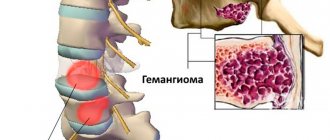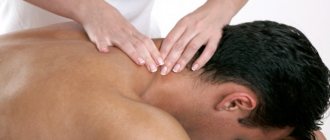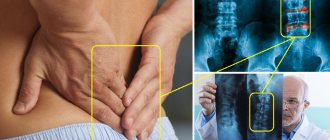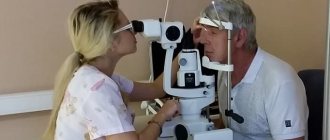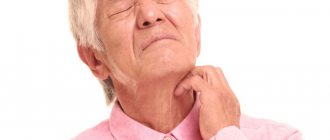Today, spinal diseases affect more people of working age due to the specific nature of their work activities. The degree of activity during work can be at one of the extremes. This can be static sitting or standing work (for example, office workers, combine operators, workshop employees), or hard, exhausting work (loaders, construction workers). Few pay attention to the first occurrence of pain in the lower back, back or neck and go to the doctor with the problem; pain is a signal of the onset of degenerative changes in the joints, which is what subchondral sclerosis essentially is.
Symptoms of osteoporosis of the spine
Osteoporosis can occur for a very long time without any symptoms. In the early stages, you can determine it by measuring your height and comparing it with what it was at 20-25 years old. Also, changes in posture will indicate osteoporosis of the thoracic spine or cervical spine.
As osteoporosis of the spine develops, the following signs appear:
- Pain. It occurs mainly under compression loads. This could be a fall or lifting something heavy. Osteoporosis of the lumbar spine is manifested by pain with sudden turns of the torso. The pain syndrome may subside 4-6 weeks after onset. If the spine is affected by multiple microfractures, this leads to modification of the vertebrae and their gradual bending. Patients in this case experience periodic pain, which worsens when laughing, sneezing, coughing, or changing body position after sitting for a long time.
- Decreased growth. The difference between previous and current indicators can be 10-15 cm.
- Osteoporosis of the thoracic spine is manifested by a decrease in the size of the chest. Because of this, the arms look unnaturally long.
- Spinal deformity. Occurs when more than one vertebra is affected by the disease. Typically, such symptoms are caused by osteoporosis of the lumbar spine when 1-2 vertebrae are affected. Deformation also occurs when the thoracic region - 10-12 vertebrae - is involved in the process. As a result, the person becomes stooped, and as the disease progresses, a hump or humps may form.
- Reducing the distance between the pelvic bones and the rib area. In this case, a person with osteoporosis of the spine feels pain in the side.
- Pain in the vertebrae on palpation. This symptom occurs with a recent compression fracture.
- The pathological process may involve nerve roots and the spinal cord. In this case, a variety of dysfunctions arise: from loss of sensitivity in some parts of the body to paralysis of the limbs.
- Osteoporosis of the cervical spine causes pain after long periods of sitting or standing, weakness and soreness in the arms, discomfort in the shoulder girdle, headaches, surges in blood pressure, numbness, tingling and cramps in the arms.
- Brittle hair, deterioration of teeth and nails.
General information
Osteosclerosis is a pathological condition caused by an increase in bone density and thickening of bone trabeculae (beams), a decrease in the volume of bone marrow cells as a result of excessive formation of bone components, as well as compact substance.
It develops under conditions of imbalance in the functional viability of osteoclasts and osteoblasts - when synthesis processes prevail over destruction processes. Osteosclerosis can be physiological - it is noted during the development of skeletal structures in growth zones, but it is pathological osteosclerosis that is dangerous, since it leads to a decrease in the elasticity of bone formations.
Schematic representation of normal bone and osteosclerosis
Osteosclerosis may be accompanied by benign dysplasia ( melorheostosis ), inhomogeneity and spotty ossification ( osteopoikilosis ), myelofibrosis, increased fragility and failure of bone marrow tissue as in osteopetrosis . Moreover, narrowing of the bone marrow canal and its complete obliteration due to thickening of the cortical layer is possible.
Osteosclerosis occurs in the form of genetic diseases, including marble disease , which develop in childhood, as well as in the form of adult osteomyelosclerosis, which is characteristic mainly of older people.
Causes of osteoporosis
There are many reasons for the development of this pathology:
- disturbances in the functioning of the endocrine system;
- lack of physical activity, sedentary work;
- deficiency of calcium and vitamin D in the body;
- chronic gastrointestinal diseases;
- negative heredity;
- long course of glucocorticosteroids (more than 1 month);
- menstrual irregularities in women, amenorrhea;
- alcohol abuse;
- smoking;
- drinking more than 5-6 cups of coffee per day;
- excessive physical activity;
- a metabolic disorder in which the bones do not receive enough necessary vitamins and microelements;
- poor nutrition – osteoporosis of the spine can be caused by both a long-term and poorly designed diet, and the predominance of fatty foods, which interfere with the absorption of important nutrients.
Pathogenesis
The mechanism of osteosclerosis is based on the opposite condition to osteoporosis , reflecting reparative processes in the bone - in the form of an increase in the bone-forming ability of osteoblasts. This nonspecific reaction in the form of an increase in bone mass occurs due to periosteal and endosteal ossification in response to various diseases, injuries and processes in the body. To stimulate true osteosclerosis, pathological processes are sufficient, the substrate of which is located in the spaces between the bone beams.
In addition to pathological changes in the bone—thickening of the trabeculae and compact substance—cancellous bone tissue also undergoes changes, taking on the appearance of a narrow-loop structure or a compact mass.
Stages of development of spinal osteoporosis
| Stage | Description |
| I | There are no external manifestations of the disease. It is usually discovered as part of preventive diagnostics or even by accident. However, you can notice signs of calcium deficiency - hair loss, brittleness, dullness, dry skin, brittleness and splitting of nails. |
| II | The person experiences pain between the shoulder blades and/or in the lower back. It intensifies under load. Cramps occur in the calves, and disruptions in the functioning of the heart are observed. The bones begin to break down due to decreased density, which can be seen on x-rays. |
| III | The deformation of the vertebrae is already becoming clearly visible. A person feels pain in several parts of the spine, which does not go away on its own. Height decreases and a hump may appear. At this stage there is already a danger of fractures even with a small load. |
| IV | This is the most severe form of the disease, in which the vertebrae are almost “transparent”, flattened, and the spinal cord canal is expanded. The man is already noticeably shorter. The vertebrae become wedge-shaped, which increases the likelihood of their displacement. At this stage, the patient cannot take care of himself even in everyday matters. |
Types of osteoporosis of the spine
Osteoporosis of the spine, treatment of which must begin immediately when the listed symptoms are detected, is classified according to several criteria.
Based on localization, the following types of osteoporosis are distinguished:
- cervical region;
- thoracic region;
- lumbar region.
According to the severity of the consequences, the disease is:
- with the presence of pathological fractures;
- without pathological fractures.
The main three types of spinal osteoporosis are:
- Senile. This is an age-related type of disease, which is associated with a gradual disruption of the process of bone tissue restoration and its destruction.
- Postmenopausal. This type appears in women after the onset of the last menstruation in the first 5-10 years of menopause.
- Combined. It combines both types and only affects women.
According to the mechanism of occurrence, osteoporosis is:
- Primary. It develops as an independent pathology and is systemic in nature. Accounts for up to 94% of all types of osteoporosis.
- Secondary. It is caused by various reasons and factors, develops against the background of other diseases, after organ transplantation, etc.
Primary osteoporosis of the spine is divided by origin into:
- genetically determined - occurs among members of the same family, is inherited;
- juvenile – the so-called “teenage”, the causes of which are currently unknown to medicine;
- involutive - occurs in the process of general aging of the body, includes postmenopausal, senile (that is, senile, appearing after 70 years), presenile (develops mainly in men and at an earlier age - after 50 years);
- idiopathic - appears in men over 25 years of age and in women before menopause; the etiology of this disease is unknown.
Based on prevalence, osteoporosis is divided into:
- localized – affects one part of the spine;
- diffuse - a common pathology that affects not only the entire spine, but also other bones of the skeleton.
Secondary osteoporosis is divided according to the factors that caused it. These are disturbances in the functioning of the following body systems:
- digestive;
- endocrine;
- hematopoietic;
- urinary (kidney disease);
- collagenosis.
Consequences and prognosis
When talking about the consequences, the cause of the pathology should be taken into account. If we are talking about physiological osteosclerosis, then there is nothing to be afraid of - this process must end in a timely manner, in accordance with the age norm. If this does not happen, treatment and diet are prescribed.
Post-traumatic osteosclerosis is part of the recovery process. This is normal. After fractures, trabeculae form chaotically, and in order to give them the desired direction, a measured load is required. If the exercises are performed in a timely manner, the prognosis is favorable.
If we are talking about pathological osteosclerosis, then the following complications are possible:
- pathological bone fractures;
- inflammatory process in cartilage and joints;
- destruction of bone tissue;
- osteomyelitis.
In severe stages of the disease, a deferment or complete exemption from military conscription is given. Disability is granted for complications of the disease.
How is osteoporosis diagnosed?
The most informative, simple, painless and fastest diagnostic method is ultrasound densitometry. This study allows you to determine bone density and the level of risk of fractures in literally 5 minutes. Densitometry can detect osteoporosis at an early stage and even minimal bone loss. During treatment, it is carried out to determine the effectiveness of therapy and the dynamics of changes in bone density.
Laboratory research:
- determination of TSH level (in osteoporosis it is elevated);
- general blood test (reduced hemoglobin level);
- a blood test to check calcium levels (it will be elevated because calcium is washed out of the bones in the blood);
- determination of alkaline phosphatase in the blood (will be increased);
- urine test for calcium (any deviation may indicate pathology);
- determination of testosterone levels in men (in osteoporosis it is reduced);
- markers of bone destruction - deoxypyridinoline, pyridinoline, C- and N-terminal telopeptide, beta-CrossLaps (these indicators will be increased in the presence of the disease).
Additional instrumental and hardware studies:
- radiography (reveals a severe stage of osteoporosis of the spine, the treatment of which will be difficult);
- osteoscintigraphy (an isotope method that allows you to exclude other causes of pain in the spine and detects recent fractures);
- bone biopsy (needed for atypical types of osteoporosis);
- MRI (can detect fractures and bone marrow swelling).
How to treat spinal osteoporosis
Therapy for this disease includes significant dietary adjustments, taking special medications, lifestyle changes and, in some cases, physical therapy.
Features of nutrition for osteoporosis
The main thing is the high calcium content in food. To restore bone tissue, a person needs 1000-1200 mg of calcium per day. For comparison: usually the daily dose when consuming dairy products is 600-800 mg. Therefore, it is necessary to add calcium supplements. In addition, calcium can be “raised” by eating as many foods high in calcium as possible: nuts, dried fruits, dairy products, vegetables, olives, celery, white cabbage, onions, fish.
Important! If you drink 0.5 liters of milk, you will satisfy the daily need for protein by 20%, phosphorus by 10%, calcium by 72%, iodine by 22%, and various vitamins by 30%.
If a person is lactose intolerant, then other foods containing calcium should be consumed. This is a glass of calcium-fortified orange juice per day (500 mg of calcium), ¾ cup of cereals (200-250 mg), ½ cup of boiled soybeans (90 mg), 1 orange (50 mg), ½ cup of boiled broccoli (35 mg) .
In order for calcium to be better absorbed, vitamin D is necessary. It is synthesized in the body under the influence of ultraviolet radiation. However, in the middle zone, people often experience a deficiency of it due to the small number of sunny days per year. Therefore, it is necessary to consume more foods containing vitamin D: meat, eggs, butter. However, it is possible to get up to 100 IU per day from food, which is not enough, because you need from 600 to 1000 IU. Therefore, vitamin D is added in tablet form.
Vitamin A, phosphorus and magnesium are also needed for good calcium absorption. The latter element is found in large quantities in buckwheat, bananas, oatmeal, millet, peanuts, sunflower and pumpkin seeds, cheese, peas, beans, and green peppers. If you simply consume magnesium, then 2/3 of the amount received will be excreted from the body. You can increase digestibility with vitamin B6.
The diet should contain enough protein - 1 g per kg of weight per day. To do this, you need to eat more meat, egg whites, and green vegetables. You can include protein shakes in your diet.
The balance between phosphorus and calcium is important. There should be twice as much calcium. The content of these substances in the body should be regularly checked by donating blood as prescribed by a doctor. Phosphorus is found in large quantities in veal, beef, millet, hard cheese, pumpkin seeds, egg whites, beef and pork liver, milk, white beans, nuts, grain bread, chicken, turkey, and duck. Your doctor should also explain how to maintain proper sodium levels.
In women, osteoporosis most often develops when estrogen production is disrupted. To maintain the level of female hormones, you need to eat foods containing phytoestrogens - all types of greens, soy, legumes, raw nuts.
Nutrition and diet
Diet is not the main treatment. However, some dietary adjustments are required. First of all, you should think about the amount of food - you should not overeat, food should completely cover a person’s energy needs, but not exceed them.
When the bones of the lower extremities and spine are affected, it is very important to normalize weight if there is excess weight.
Required and permitted products:
- milk and dairy products, preferably low-fat;
- dietary meat and offal – liver, heart;
- fresh fruits - apples, grapes, pears, bananas;
- cereals, primarily buckwheat and pearl barley.
These products contain calcium, which is necessary for the construction of normal bone tissue, supporting healthy regeneration processes and trabecular formation. Foods that should be limited are bread and pastries, especially white ones, sweets, alcohol and fatty foods.
How to get rid of pain from osteoporosis
The causes of pain due to osteoporosis vary. They can be caused by fractures, osteoarthritis, and degenerative processes in the intervertebral discs.
Emergency care for acute pain
The patient is prescribed analgesics that have a peripheral effect. They are more effective than centrally acting analgesics. Peripheral painkillers are paracetamol, aspirin, metamizole. NSAIDs (non-steroidal anti-inflammatory drugs), such as ibuprofen, are also good for relieving acute pain.
Important! NSAIDs negatively affect the gastric mucosa. Therefore, they need to be taken in short courses. To reduce harm, prescribe Omeprazole - 20 mg at night or 2-3 times a day, 20 mg with meals, if unpleasant symptoms such as heartburn have already appeared.
Bone pain is well eliminated by bisphosphonates, which are included in the course of treatment.
With a recent fracture
In this case, the pain is relieved with opioid analgesics. These include Tramadol. Such drugs also need to be used against the background of Omeprazole and with caution, because they can cause dizziness, which provokes falls and new injuries. Sometimes the drug Pregabalin is prescribed. It is effective if nerve endings are damaged or pinched.
To eliminate the consequences of a fracture and strengthen the spine, a new and effective “cementing” technique is used. A special substance is injected percutaneously into the vertebrae, which hardens and strengthens the bone tissue.
Chronic pain and long term outlook
When the pain syndrome is under control, the patient should direct all efforts to strengthening the muscle corset. For this purpose, physiotherapy and special gymnastics are used. The exercise and physical therapy program is developed individually for each patient. One of the best methods of relieving stress from the spine and simultaneously strengthening the back muscles is swimming.
Drug treatments for osteoporosis
When the diagnosis has already been confirmed and bone density has been proven to be reduced, the doctor selects special medications:
- calcium supplements to stop the loss of bone density;
- bisphosphonates, which prevent bone loss;
- anabolic agents that strengthen bones;
- antiresorptive drugs that stop spinal deformation;
- supplements that contain vitamin D, as well as both vitamin D and calcium.

